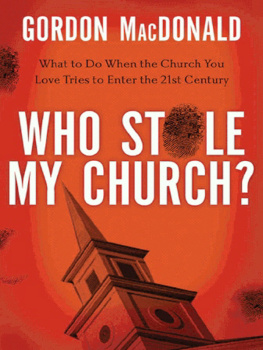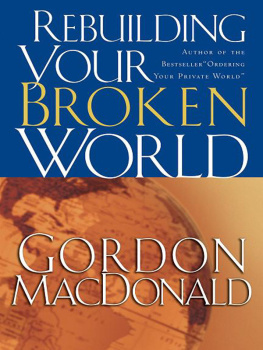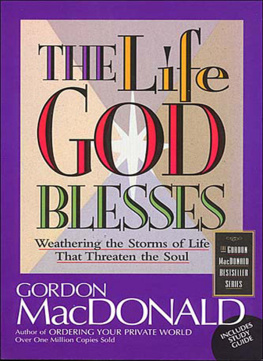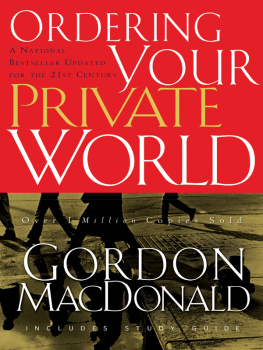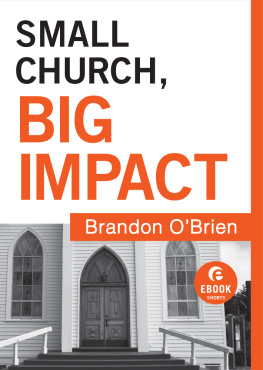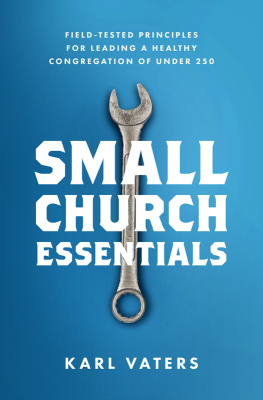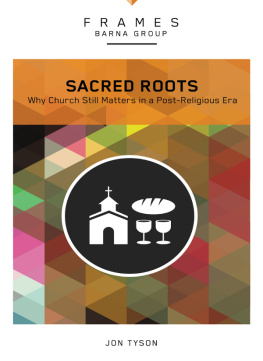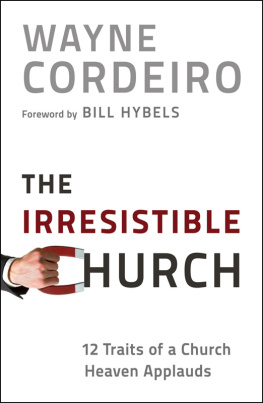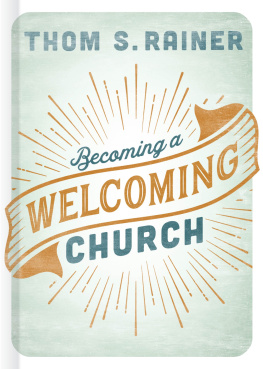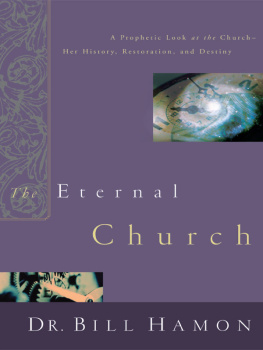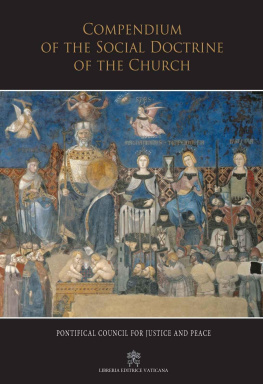Who Stole My Church?
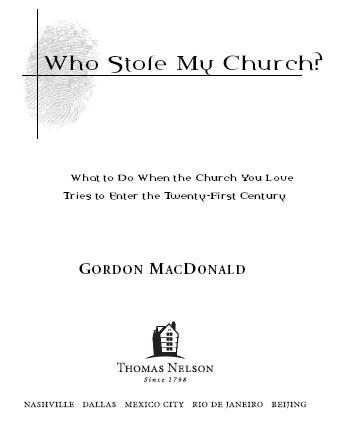
Other Books by Gordon MacDonald
A Resilient Life
Rebuilding Your Broken World
A Heart for the Master
Mid-Course Correction
Heart Connections (with Gail MacDonald)
Christ-Following (with Trevor Hudson)
When Men Think Private Thoughts
The Life God Blesses
Renewing Your Spiritual Passion
Restoring Joy to Your Inner World
Married for Good (with R. Paul Stevens)
Restoring Your Spiritual Passion
Ordering Your Private World
The Effective Father
2007 by Gordon MacDonald
All rights reserved. No portion of this book may be reproduced, stored in a retrieval system, or transmitted in any form or by any meanselectronic, mechanical, photocopy, recording, scanning or otherexcept for brief quotations in critical reviews or articles, without the prior written permission of the publisher.
Published in Nashville, Tennessee, by Thomas Nelson. Thomas Nelson is a registered trademark of Thomas Nelson, Inc.
Published in association with the literary agency of Wolgemuth & Associates, Inc.
Thomas Nelson, Inc., titles may be purchased in bulk for educational, business, fund-raising, or sales promotional use. For information, please e-mail SpecialMarkets@ThomasNelson.com.
All Scripture quotations, unless otherwise indicated, are taken from The Holy Bible, New International Version (NIV). 1973, 1978, 1984 by International Bible Society. Used by permission of Zondervan Publishing House. All rights reserved.
Library of Congress Cataloging-in-Publication Data
MacDonald, Gordon, 1939
Who stole my church? : what to do when the church you love tries to enter the twenty-first century / Gordon MacDonald.
p. cm.
ISBN 978-0-7852-2601-7 (hardcover)
1. Church renewal. 2. ChangeReligious aspectsChristianity. 3. Church history21st century. I. Title.
BV600.M284 2007
262.001'7dc22
2007031149
Printed in the United States of America
07 08 09 10 11 QW 5 4 3 2 1
CONTENTS
Dedication
To the five congregations who gave me theopportunity to serve them as their pastor.
CLOUGH VALLEY BAPTIST CHURCH
St. Francis, Kansas (196466)
FIRST BAPTIST CHURCH
Collinsville, Illinois (196672)
GRACE CHAPEL
Lexington, Massachusetts (197284; 199299)
TRINITY BAPTIST CHURCH
Manhattan, New York (19891992)
CENTERPOINT CHURCH
Concord, New Hampshire (200307)
The title of this book, Who Stole My Church?, springs from a conversation a few years ago with a distraught man who felt betrayed by the church he had invested in for most of his adult years. From his perspective everything had changedovernight, he saidinto something that made him feel like a stranger in the place hed always thought of as his spiritual home.
I listened to him describe what sounded like ecclesiastical carnage. Programs had been dumped, traditional music trashed, preaching styles and topics revolutionized, symbols of reverence (appropriate clothing, crosses, communion tables, and pulpits come to mind) thrust aside.
His anguish (and his anger) began with a young pastor who had been appointed with a challenge from the churchs leadership to stir things up with a new vision. His mandate: make the church grow like the Willow Creeks, the Saddlebacks, the Mars Hills, and all the other megachurches that have appeared during the last decade.
According to my friend, most of the church membersin particular, the older generationhad no idea what they were getting themselves into when all the growth talk began. Who would protest against, he asked, the idea of finding fresh ways to evangelize the unchurched? But what people expected was merely a fresh voice in the pulpit and a pro-gram or two imported from more successful churches.
Heres what I heard him saying. What he and his fellow church members had not anticipated was a total shift in the churchs culture, a reinvention (a favorite word of mine) of ways to love God and serve people. What they did not see coming was a reshuffling of the churchs priorities, so that lost and broken people rather than found and supposedly fixed people became the primary target audience. In summary: virtually everything in the life of theirchurch under new leadership became focused on reaching people who were not yetthere.
It was during that part of the conversation that my lunch partner finally said, Our church has been stolen out from under us. Its been hijacked. His solution to the problem? To leave and search for another church that appreciated the older and better church ways his generation was familiar and comfortable with.
As I recall the conversation, my friend was less than delighted when he dis-covered that I wasnt completely sympathetic to his cause. I tried to find a kind way to say, Get used to it, but I wasnt very successful.
My parting comment that day was something like this: You need to think about the fact that any church that has not turned its face toward the younger generation and the new challenges of reaching unchurched people in this world will simply cease to exist. Were not talking decadeswere talking just a few years.
How many people of varying ages are feeling out of alignment with their churches today? Some of them think that their churches arent adapting fast enough to new realities, and others think their churches have simply changed too much. Sadly, more than a few at both of these extremes address the problem by just dropping out. Some stick in there but take on the role of bitter critics, and they sap the strength of the community in their own way.
Here and there, however, are marvelous people who seem to understand that a church is not meant to be a club organized for the convenience of insiders but a cooperative where people combine together to grow spiritually, to worship the triune God, and to prepare themselves for Christian living and service in the larger world.
Every book can probably be traced back to a point in time when a fresh idea was birthed in the authors mind. That lunch conversation and the commentOur church has been stolen out from under usbecame the starting point for this book.
Many are the books on church change. Usually they are written from the stand-point and the instruction of the change agent, the leader (like my friends new pastor) who has the responsibility to bring about something new. In this book, however, I decided to deal with the subject from the perspective of some of the people who are powerfully affected by changethe dear people in the pew who have to live with, and even support, the new ways.
My first attempt at writing about church change was abortive. I could not escape the feeling that I was writing one more dull book on an overworked subject. So I restarted my project, but in a way Id never tried before. I decided to create an imaginary New England church in which there was a small collection of average people who were bumping up against change issues and resisting them.
Once I set these people in motion, I asked myself: If I were to enter the storyas I really am, what would I say to them? How might I engage with them and persuadethem to take a fresh look at the realities in our world that do indeed require anew kind of church?
My imagined people are all in their fifties and sixties. They are from the so-called builder and boomer generations, people who were once very much at the center of their churches and have now relinquished control and influence to others younger than they are. Once I had them all in their proper places in my mind, it was as if they took over the story and began to tell it for me. I just had to do the typing.
Next page
